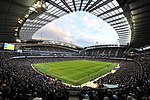Velopark tram stop
Greater Manchester railway station stubsTram stops in ManchesterTram stops on the Bury to Ashton-under-Lyne lineUnited Kingdom rapid transit stubsUse British English from June 2017

Velopark is a tram stop on the East Manchester Line (EML) of Greater Manchester's light-rail Metrolink system. It opened on 11 February 2013, after a three-day free trial for local residents. The stop was constructed as part of Phase 3a of the Metrolink's expansion, and is located beside Manchester Velodrome, in Clayton, Manchester, England. During planning and construction phases, the stop was known as New East (for Velodrome) and as Sportcity-Velodrome.
Excerpt from the Wikipedia article Velopark tram stop (License: CC BY-SA 3.0, Authors, Images).Velopark tram stop
Ashton New Road, Manchester Bradford
Geographical coordinates (GPS) Address Nearby Places Show on map
Geographical coordinates (GPS)
| Latitude | Longitude |
|---|---|
| N 53.4823 ° | E -2.19301 ° |
Address
Velopark
Ashton New Road
M11 4TQ Manchester, Bradford
England, United Kingdom
Open on Google Maps






